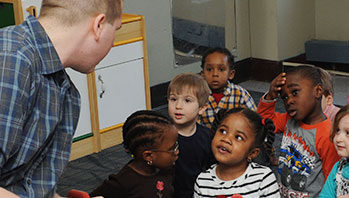- leaf vegetables (such as lettuce and spinach with roots attached, if possible)
- root vegetables (such as carrots, garlic, onion, and radishes with leaves attached, if possible)
- leaf
- plant
- root
- vegetable
MA Standards:
Speaking and Listening/SL.PK.MA.1: Participate in collaborative conversations with diverse partners during daily routines and play.
Language/L.PK.MA.6: Use words and phrases acquired through conversations, listening to books read aloud, activities, and play.
MA Draft STE Standards
Life Sciences/From Molecules to Organisms: Inheritance and Variation of Traits/LS1/3.C: Use their sense in their exploration and play to gather information. [Structure and Function]
Head Start Outcomes:
Language Development/Receptive Language: Attends to language during conversations, songs, stories, or other learning experiences.
Language Development/Expressive Language: Uses language to express ideas and needs.
Logic and Reasoning/Reasoning and Problem Solving: Classifies, compares, and contrasts objects, events, and experiences.
Science Knowledge/Scientific Skills and Method: Observes and discusses common properties, differences, and comparisons among objects.
PreK Learning Guidelines:
English Language Arts/Language 2: Participate actively in discussions, listen to the ideas of others, and ask and answer relevant questions.
Science and Technology/Living Things and Their Environment 15: Use their senses of sight, hearing, touch, smell, and taste to explore their environment using sensory vocabulary.
Talk Together: Roots and Leaves

© Commonwealth of Massachusetts, Department of Early Education and Care (Jennifer Waddell photographer). All rights reserved.
STEM Key Concepts: Many foods that animals, including humans, eat come from plants; We eat certain leaves, roots, fruits, and seeds
ELA Focus Skills: Listening and Speaking, Vocabulary
Safety Tips:
- Remind children to wash their hands before and after the activity.
- Children’s dietary needs and allergies have to be taken into account before introducing them to any food items.
Ask children to share what they know about, and what it’s like to eat, root and leaf vegetables. Display the vegetables for children. Ask,
- What do you notice about the roots and leaves? Can you describe how they look? Smell? Feel?
- How are the roots different from the leaves? How are they similar?
- Do any of the plants smell similar? How do they smell different?
Then encourage children to talk about how the different types of vegetables taste. Give children a chance to taste the vegetables, then ask,
- What did you notice about the taste of the lettuce leaves? Do they taste similar to the carrots?
- What was different about the texture of the leaf plant in your mouth and the texture of the root plant?
- Do you think you would want to eat the roots of the lettuce plant? Why do you think that?
- Why do you think we eat only some parts of the plants?
